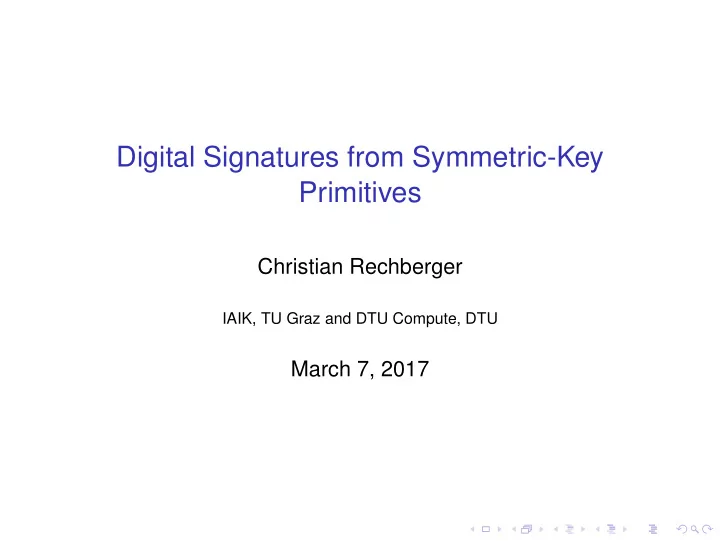

Digital Signatures from Symmetric-Key Primitives Christian Rechberger IAIK, TU Graz and DTU Compute, DTU March 7, 2017
Based on Joint Work With David Derler Claudio Orlandi Sebastian Ramacher Daniel Slamanig TU Graz Aarhus University TU Graz TU Graz
Overview Most known signature schemes ◮ Based on structured hardness assumptions ◮ Except hash-based signatures Why omit structured hardness assumptions? ◮ Favorable in post-quantum context Are there alternatives to hash-based signatures?
High-level view In recent years there was progress in two very distinct areas ◮ Symmetric-key primitives with few multiplications ◮ Practical ZK-Proof systems over general circuits We take advantage of both and propose new signature schemes
Digital Signatures from NIZK One-Way Function f : D → R . ◮ Easy to evaluate ◮ Hard to invert R D , ◮ sk ← pk ← f ( sk ) . Signature ◮ Proof of knowledge of sk so that pk = f ( sk ) . + Some mechanism to bind message to this proof Security (informal): ◮ Can only create proof if I actually know sk .
OWF or PRF with few multiplications? name security λ · a AES 128 5440 GF(2) approach GF(2 4 ) approach AES 128 4000? AES 256 7616 GF(2) approach SHA-2 256 > 25000 SHA-3 256 38400 Noekeon 128 2048 Trivium 80 1536 PRINCE 1920 Fantomas 128 2112 LowMCv2 128 < 800 LowMCv2 256 < 1400 Kreyvium 128 1536 > 100000 FLIP 128 MIMC 128 10337 MIMC 256 41349
Signature Size Comparison | σ | name security AES 128 339998 AES 256 473149 SHA-2 256 1331629 SHA-3 256 2158573 LowMCv2 (+ 30% security margin) 256 108013
Example of exploration of variation of LowMC instances Runtime vs. Signature Size, [n]-[k]-[m]-[r], n=256 400 256-256-1-316 300 200 150 100 Time [ms] 50 256-256-10-38 256-256-42-14 Sign ( Fish ) Verify ( Fish ) 100 150 Size [kB] Figure : 128-bit PQ security. Measurements for instance selection (average over 100 runs).
Comparison with other recent proposals Scheme Gen Sign Verify | sk | | pk | | σ | T M PQ Fish-256-10-38 0 . 01 29 . 73 17 . 46 32 32 / 64 116 K × ROM � MQ 5pass 1 . 0 7 . 2 5 . 0 32 74 40 K × ROM � SPHINCS-256 0 . 8 1 . 0 0 . 6 1 K 1 K 40 K � SM � BLISS-I 44 0 . 1 0 . 1 2 K 7 K 5 . 6 K � ROM � Ring-TESLA 17 K 0 . 1 0 . 1 12 K 8 K 1 . 5 K × ROM � TESLA-768 49 K 0 . 6 0 . 4 3 . 1 M 4 M 2 . 3 K × (Q)ROM � FS-V´ 160 126 K × eron n/a n/a n/a 32 ROM � SIHDp751 16 7 K 5 K 48 768 138 K × QROM � Table : Timings (ms) and key/signature sizes (bytes)
Conclusion and Outlook Two new efficient post-quantum signature schemes ◮ Based on LowMC instances New questions in various directions ◮ Alternative symmetric primitives with few multiplications ◮ Something new, even more crazy than LowMC? ◮ 256-bit secure variant of Trivium/Kreyvium? ◮ More LowMC cryptanalysis ◮ Analysis regarding side-channels
Thank you. Preprint: http://ia.cr/2016/1085 Full implementations and benchmarking: https://github.com/IAIK/fish-begol Supported by:
Signature Size Fish R D , pk ← f ( sk ) ◮ Recall: OWF f : D → R , sk ← ◮ Security parameter: κ OWF represented by arithmetic circuit with ◮ ringsize λ ◮ Multiplication-count a Signaturesize = c 1 + c 2 · ( c 3 + λ · a ) with c i = f i ( κ ) , reduction of constants using optimizations from ZKB++ [GCZ16] For Begol: signature size roughly doubles.
References I [ARS + 15] Martin R. Albrecht, Christian Rechberger, Thomas Schneider, Tyge Tiessen, and Michael Zohner. Ciphers for MPC and FHE. In EUROCRYPT , 2015. [ARS + 16] Martin Albrecht, Christian Rechberger, Thomas Schneider, Tyge Tiessen, and Michael Zohner. Ciphers for MPC and FHE. Cryptology ePrint Archive, Report 2016/687, 2016. [BG89] Mihir Bellare and Shafi Goldwasser. New paradigms for digital signatures and message authentication based on non-interative zero knowledge proofs. In CRYPTO , 1989. [DOR + 16] David Derler, Claudio Orlandi, Sebastian Ramacher, Christian Rechberger, and Daniel Slamanig. Digital signatures from symmetric-key primitives. IACR Cryptology ePrint Archive , 2016:1085, 2016. [Fis99] Marc Fischlin. Pseudorandom function tribe ensembles based on one-way permutations: Improvements and applications. In Advances in Cryptology - EUROCRYPT ’99 , pages 432–445, 1999.
References II [FS86] Amos Fiat and Adi Shamir. How to prove yourself: Practical solutions to identification and signature problems. In CRYPTO ’86 , 1986. [GCZ16] Steven Goldfeder, Melissa Chase, and Greg Zaverucha. Efficient post-quantum zero-knowledge and signatures. IACR Cryptology ePrint Archive , 2016:1110, 2016. [GMO16] Irene Giacomelli, Jesper Madsen, and Claudio Orlandi. Zkboo: Faster zero-knowledge for boolean circuits. In USENIX Security , 2016. [IKOS07] Yuval Ishai, Eyal Kushilevitz, Rafail Ostrovsky, and Amit Sahai. Zero-knowledge from secure multiparty computation. In Proceedings of the 39th Annual ACM Symposium on Theory of Computing, San Diego, California, USA, June 11-13, 2007 , pages 21–30, 2007. [Unr15] Dominique Unruh. Non-interactive zero-knowledge proofs in the quantum random oracle model. In EUROCRYPT , 2015.
Recommend
More recommend